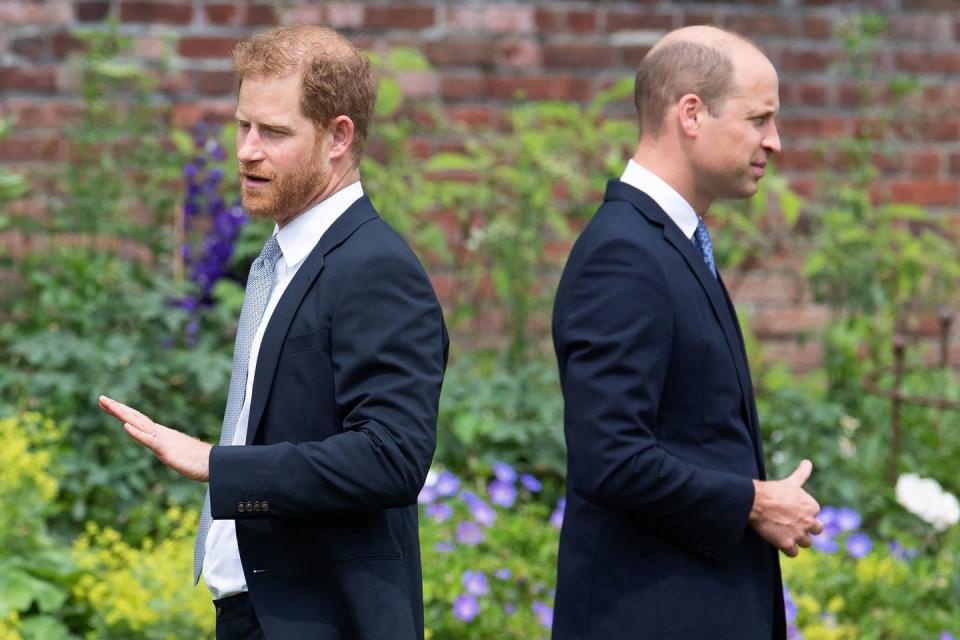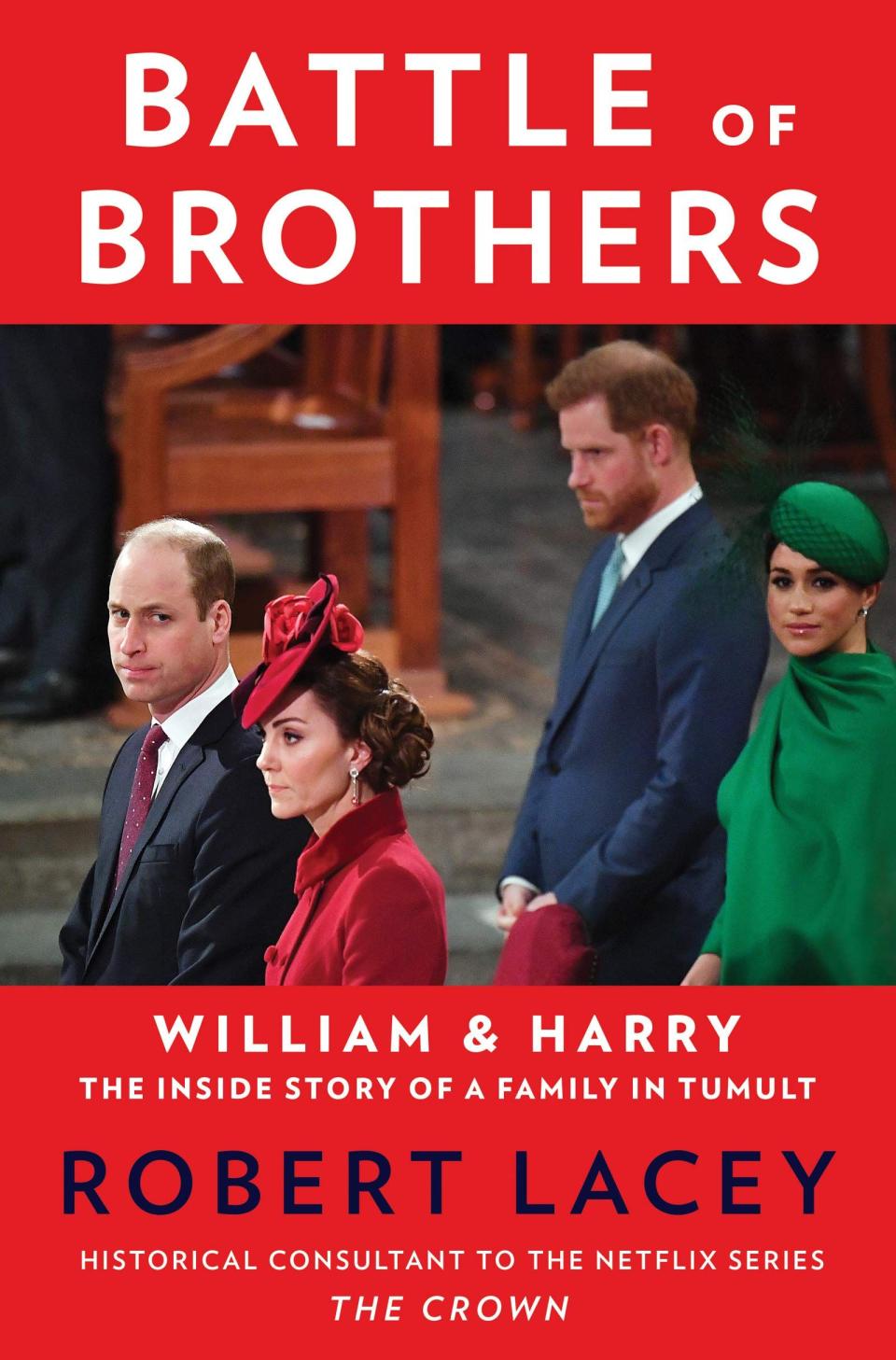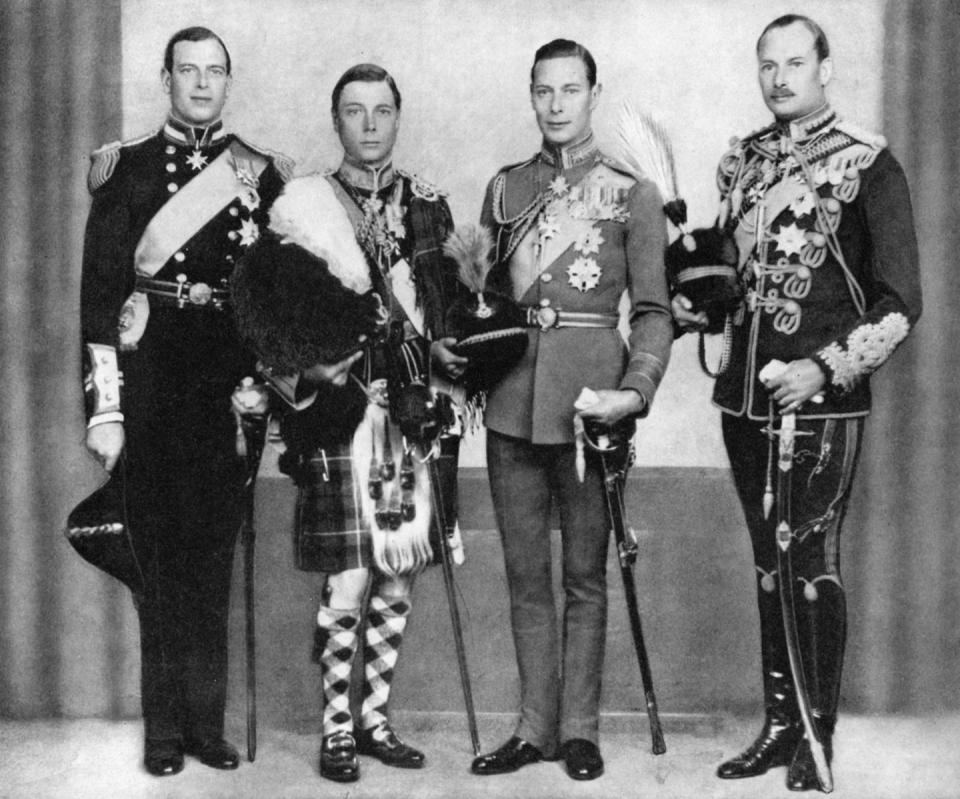5 Notable Royal Feuds, From Cleopatra and Her Siblings to Princes Harry and William
- Oops!Something went wrong.Please try again later.
- Oops!Something went wrong.Please try again later.
- Oops!Something went wrong.Please try again later.
- Oops!Something went wrong.Please try again later.
- Oops!Something went wrong.Please try again later.
- Oops!Something went wrong.Please try again later.
- Oops!Something went wrong.Please try again later.
- Oops!Something went wrong.Please try again later.
- Oops!Something went wrong.Please try again later.
"Hearst Magazines and Yahoo may earn commission or revenue on some items through these links."
For the past few years, the world has been fascinated by the unfolding drama of Prince Harry and Prince William’s sibling conflict. But they aren’t the only ones to see a close sibling bond fall apart amid the public pressures of their roles.
In royal families, there’s only one throne to sit on, so there have been feuds over who gets to reign. Some heirs lower down in the line of succession have criticized the current king or queen or attempted to seize power themselves. Other royals have fallen out over who will be forced to wear the crown.
From how Cleopatra’s rule in Egypt affected her siblings to conflicts between princely brothers, these five famous royal feuds are examples of what can go awry in royal families. There are the highest of stakes in these conflicts: the losers may be imprisoned, exiled, or even executed.
A Deepening Rift Between U.K.’s Prince Harry and Prince William

Growing up, William, the Prince of Wales, and Harry, the Duke of Sussex, were assigned specific roles in the family, like many royal children before them: William was the heir to the throne and Harry the “spare.” The two were treated differently by family members; the press also varied in its coverage of the young princes. Harry was roundly condemned (and rightfully so) in 2005 when he chose to wear a Nazi uniform and swastika armband to a costume party. But William, who’d helped select his younger brother’s outfit, wasn’t mentioned. It wasn’t the only time the media would treat Harry as a scandal-prone troublemaker while William escaped criticism. Even so, the princes weren’t always at odds—the death of their mother, Princess Diana, in 1997 forged a lasting bond.
But in 2017, William counseled a lovestruck Harry not to rush his relationship with Meghan Markle. The younger prince didn’t appreciate the advice. After he and Markle wed in 2018, Harry resented William for not doing more to welcome the American actor into the royal family. Harry says William physically attacked him early in 2019 during a fight about the Duchess of Sussex. According to Harry, during the altercation, William insulted Meghan, which Harry blamed on his brother’s believing negative tabloid accounts of Meghan’s behavior. In March 2019, William and Harry’s royal households, which handle communications and royal engagements, split apart.

Battle of Brothers: William and Harry – The Inside Story of a Family in Tumult
$14.25
amazon.com
After the separation, William and Kate, the Princess of Wales, continued living at Kensington Palace in London, while Harry and Meghan left Kensington for Frogmore Cottage in Windsor. At the time, the split was said to be a practical decision that would allow each prince to forge his own identity. Later accounts, such as the 2020 book Battle of Brothers: William and Harry – The Inside Story of a Family in Tumult, said the separation was part of their ongoing feud, as William believed his sister-in-law had an agenda that could hurt the monarchy.
In January 2020, Harry and Meghan publicly announced their intention to step back as senior members of the British Royal Family. The pair initially wanted to maintain some royal ties, but the royal family didn’t approve. In a meeting between Harry, William, then-Prince Charles and Queen Elizabeth II, Harry says his brother screamed at him. After the meeting, a joint statement was released to deny rumors that William had bullied Harry—but Harry said in the 2022 Netflix documentary Harry & Meghan that this was done without his knowledge. He said royal staffers “were happy to lie to protect my brother.”
Since moving to California, Harry has openly discussed how his family and the British press have treated him. Besides the Netflix documentary, there was a 2021 interview with Oprah Winfrey and the release of his memoir, Spare, this January. These actions all reportedly angered William. The brothers’ rift has deepened, and Harry feels his brother is “now on the institution’s side.” He expressed love for William in his memoir but also called his brother his archnemesis. Harry said, “There has always been this competition between us, weirdly. I think it really plays into, or was played by, the ‘heir/spare.’”
A Decades-Long Rivalry Boils Over for Jordan’s King Abdullah II and Prince Hamzah bin Hussein
King Abdullah II succeeded his father, King Hussein, on the Jordanian throne in 1999. Abdullah, born in 1962, is Hussein’s eldest son. Before Hussein died, he also named his favorite son, Abdullah’s half-brother Prince Hamzah bin Hussein, as the new crown prince and successor to Abdullah. Hamzah had been seen as a potential direct successor for Hussein, but at the time of his father’s death, he was 18 and considered too young to rule.
Abdullah hadn’t expected to be king—his uncle, who’d been crown prince for years, was still in the role when Hussein announced his last-minute shift in succession. Abdullah had mostly grown up abroad and initially had trouble speaking Arabic. In contrast, Hamzah spoke Jordanian dialects and understood the customs of the country’s traditional tribes, which serve as a power base for the monarchy. His striking resemblance to his fatheralso enhanced his popularity. But in 2004, Abdullah removed Hamzah as crown prince and made his own son his successor.
Abdullah’s reign hit a rough spot starting in 2020, as the country’s economy suffered during the COVID-19 pandemic and amid allegations of state corruption. In April 2021, Hamzah was placed under house arrest and accused of plotting to replace Abdullah. Several other people were detained as collaborators, though many were released later that month.
While under house arrest, Hamzah released a video denying any plot. He also denounced the corruption in Jordan. Weeks later, Hamzah pledged his loyalty to Abdullah. In March 2022, the royal court released an apology letter allegedly written by Hamzah to ask for his half-brother’s forgiveness.
The brothers’ feud wasn’t over, however. On April 3, 2022, Hamzah renounced his princely title due to his “personal convictions” clashing with state institutions. Abdullah said Hamzah was still delusional about taking the throne, and the palace noted that only the monarch has the right to revoke a royal title. Abdullah also restricted his half-brother’s movements and cut his contact with the outside world. The king stated his brother would “live a comfortable life, but he will not have the space he once abused to offend the nation, its institutions, and his family, nor to undermine Jordan’s stability.”
Abdication Was Only the First Straw for Edward VIII and King George VI

Edward VIII ascended to the British throne following the death of his father, George V, in January 1936. As king, Edward became head of the Church of England. At the time the Anglican Church did not permit divorced people to remarry if their former spouses were still alive. But Edward had fallen for the twice-divorced American socialite Wallis Simpson and wasn’t willing to give her up. As his spring 1937 coronation approached, he had to make a choice between love and the throne. He abdicated in December 1936. Next in the line of succession was Edward’s younger brother Albert, known as Bertie. Bertie didn’t want to be king, but he accepted the job as George VI.
George made his older brother Duke of Windsor. Yet instead of heading off into the sunset with Simpson, the duke continued to plague the new king. After marrying Simpson in 1937, Edward wanted her to be granted the title “Her Royal Highness,” something George refused. Edward also expected the state to provide him with an allowance. He even lied about his financial status to sway his sibling.
Edward would become an even bigger headache for George. In October 1937, Edward and Simpson headed to Germany, where they partied with Nazis and met Adolf Hitler. During World War II, some Nazis schemed to use him as an ally. Meanwhile, George fretted about how to keep his country safe in wartime and refused to leave Buckingham Palace in London even while the city was under constant bombardment. In 1940, Prime Minister Winston Churchill, with the king’s agreement, offered Edward governorship of the Bahamas. The appointment got the duke away from Europe and his Nazi pals.
George’s wife, Queen Elizabeth, The Queen Mother, felt the stresses of being king contributed to her husband’s early death in 1952 at the age of 56. Although Edward and Simpson spent most of their time in quasi-exile in Europe after World War II ended, he returned to England for his brother’s funeral. Following Edward’s death in 1972, Queen Elizabeth II had her uncle’s body brought back to his home country and buried on the grounds of Windsor Castle.
The Feud Between Queen Elizabeth I and Mary, Queen of Scots, Ended in Execution
Mary, Queen of Scots and Queen Elizabeth I of England never met in real life, but they still managed to have a deadly feud. Mary, the only legitimate child of King James V of Scotland, became queen in 1542, when she was 6 days old. When Mary was 5 years old, her mother sent her to France. Mary grew up in the French court and married the heir to the French throne in 1558. After her father-in-law passed away the following year, Mary’s husband became King Francis II, making her a queen in both Scotland and France. However, her husband died in 1560, and Mary returned to Scotland in 1561.
In 1565, Mary wed her second husband, the power-hungry Lord Darnley. Two years later, Darnley was murdered (people suspected Mary was involved), and within months, Mary had married his suspected killer, the Earl of Bothwell. Although she might have been forced into the union, the marriage hurt Mary’s reputation. In July 1567, Scottish nobles made her abdicate the throne in favor of her infant son, James. Mary escaped imprisonment and fled to England in 1568.
In England, Mary turned to Elizabeth I, her cousin once removed; Mary’s grandmother, Margaret, was the older sister of Elizabeth’s father, Henry VIII. Yet, Elizabeth was concerned about losing her crown to Mary. Elizabeth’s birth was delegitimized when her father had executed her mother in order to marry again. Although Elizabeth was eventually reinstated to the line of succession and became queen, some believed Mary’s claim to the English throne was stronger than Elizabeth’s.
Religious unrest between Catholics and Protestants also played a role in this feud. Elizabeth was a Protestant, while Mary was Catholic. Elizabeth opted to keep her cousin under house arrest as Catholic supporters—with Mary’s involvement—schemed to install Mary on the throne. Elizabeth refrained from putting Mary on trial until a plot to assassinate Elizabeth came to light in 1586. After Mary was found guilty, Elizabeth debated for months before signing the death warrant. Mary was executed on February 8, 1587.
Cleopatra VII’s Bloody Battle with Her Siblings for the Egyptian Throne

One of five or six children, Cleopatra VII ascended to the Egyptian throne in 51 BCE after her father’s death. She had a co-ruler: 10-year-old Ptolemy XIII, her brother. The Ptolemaic dynasty often had siblings wed, so these two tied the knot. However, it wasn’t a happy marriage. Cleopatra and her brother (or his advisers) clashed over who would rule. But by 48 BCE, Cleopatra had acquired Roman military support, thanks to her lover Julius Caesar, and defeated her brother. At some point, perhaps during the fighting or while fleeing Caesar’s forces, Ptolemy XIII drowned in the Nile River.
Cleopatra had to deal with yet another younger brother, Ptolemy XIV. But she didn’t wait around for this sibling to cause trouble. After Caesar’s assassination in 44 BCE, Cleopatra left Rome for Alexandria. Following her return that same year, Ptolemy XIV died, likely due to Cleopatra poisoning him. Her son with Caesar, Caesarion, became her co-regent.
Being Cleopatra’s sister wasn’t any easier than being her brother. Cleopatra’s younger sister, Arsinoe IV, had tried to claim the Egyptian throne amidst Cleopatra’s fight with Ptolemy XIII. Arsinoe ended up being captured and taken to Rome. Cleopatra decided to prevent her opponents from using her sister to supplant her by turning to a new lover, Mark Antony, for help. In 41 BCE, Antony arranged for Arsinoe to be put to death.
Cleopatra was only able to enjoy her kingdom for 10 years after surviving her feuding siblings. After Antony’s rival Octavian defeated Antony and Cleopatra’s forces in 31 BCE, Cleopatra killed herself—perhaps by asp bite but more likely by using a needle to administer poison.

